Abstract
Defects in the ryanodine receptor (RYR1) gene are associated with malignant hyperthermia (MH), an autosomal dominant disorder of skeletal muscle and one of the main causes of death resulting from anaesthesia. Susceptibility to MH (MHS) is determined by the level of tension generated in an in vitro muscle contracture test (IVCT) in response to caffeine and halothane. To date, mutation screening of the RYR1 gene in MH families has led to the identification of eight mutations. We describe here the identification of a novel mutation, Arg552Trp, in the RYR1 gene, which is clearly linked to the MHS phenotype in a large, well characterised Irish pedigree. Considering that the RYR1 protein functions as a tetramer, correlation of the IVCT with the affected and unaffected haplotypes was performed on the pedigree to investigate if the normal RYR1 allele in affected subjects contributes to the variation in the IVCT. The results show that the normal RYR1 allele is unlikely to play a role in IVCT variation.
Full text
PDF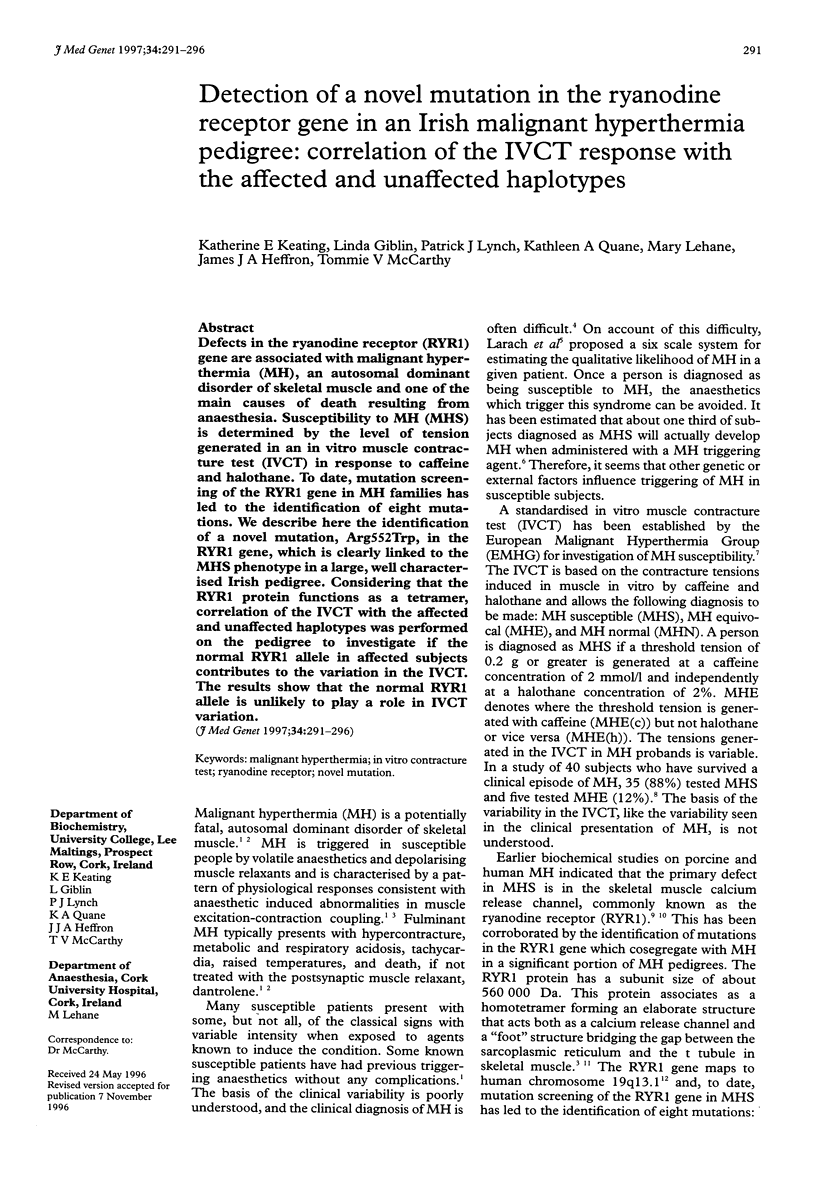
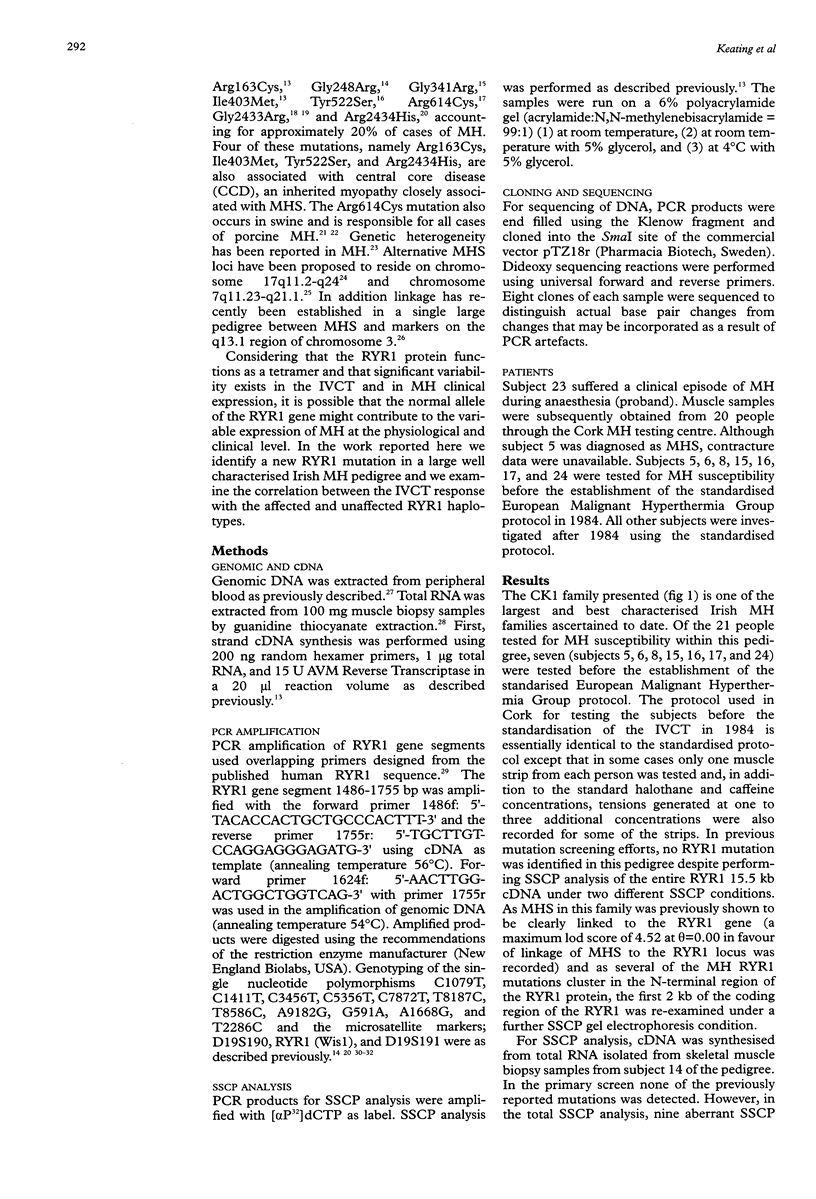
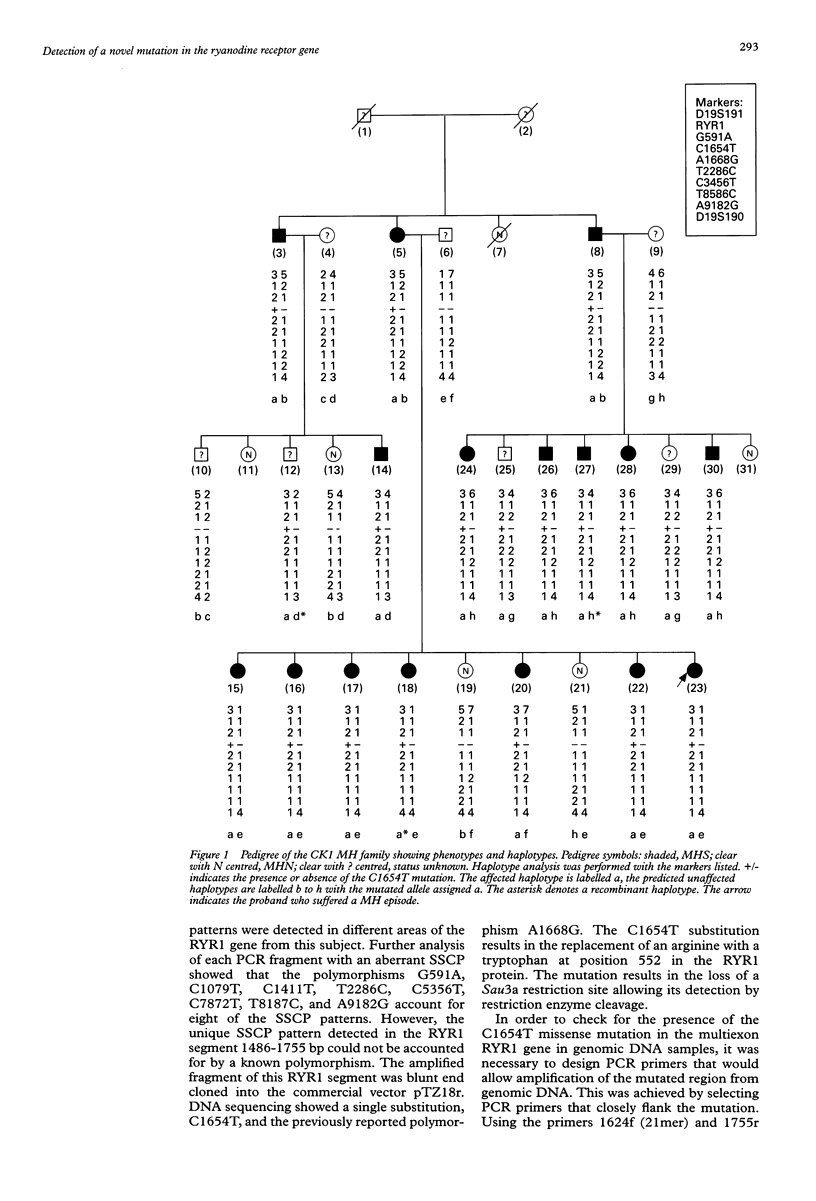
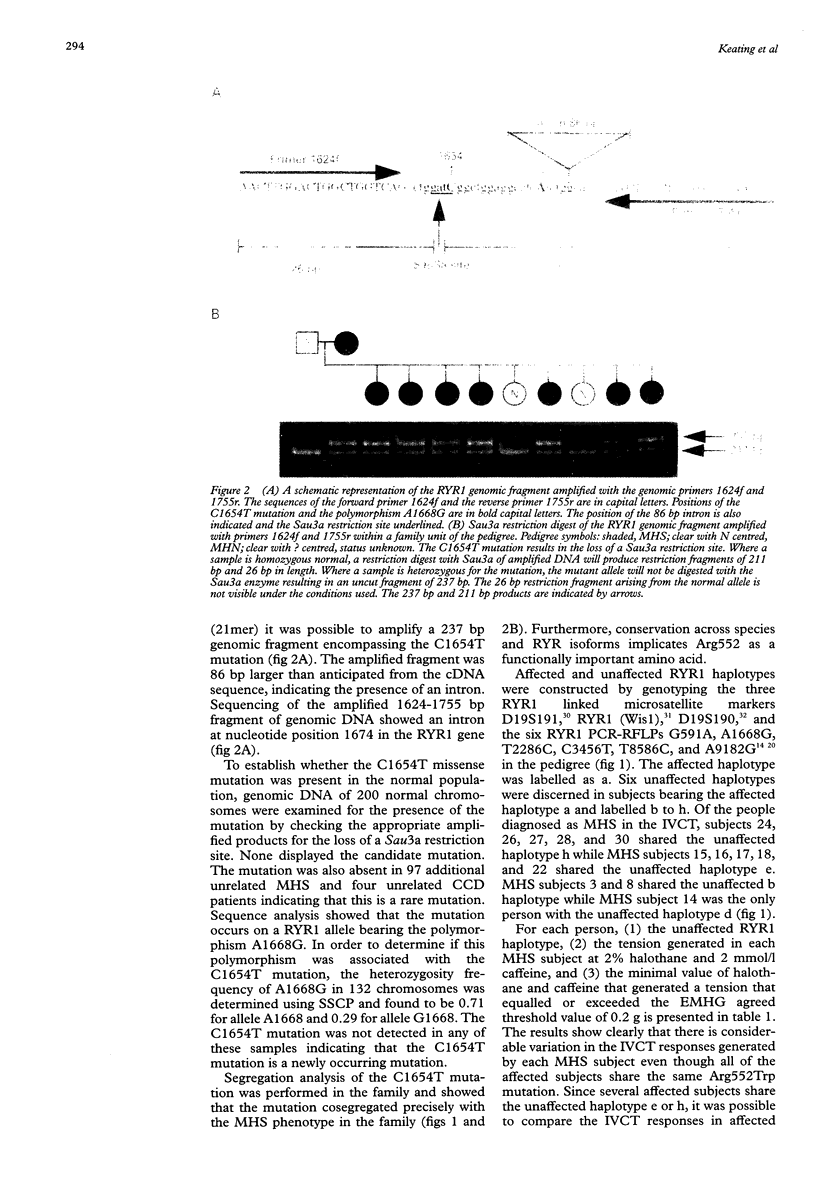
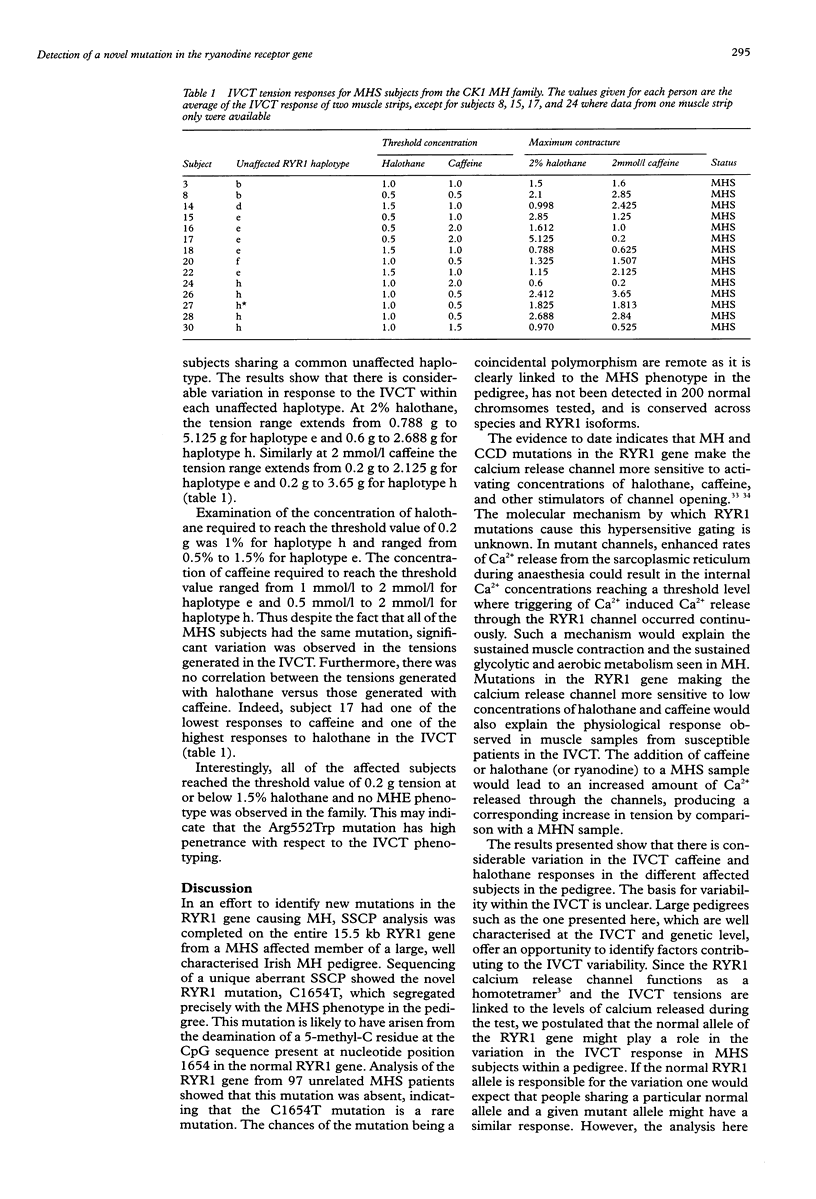
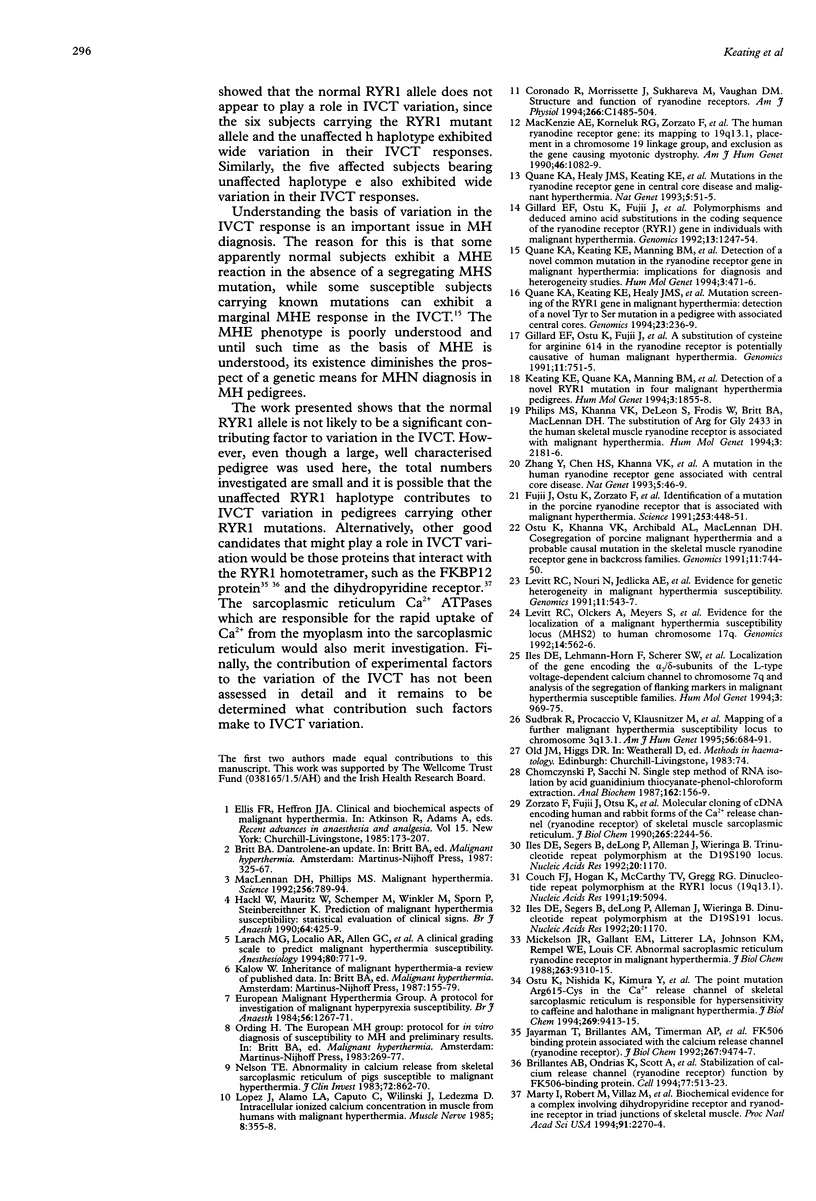
Images in this article
Selected References
These references are in PubMed. This may not be the complete list of references from this article.
- Brillantes A. B., Ondrias K., Scott A., Kobrinsky E., Ondriasová E., Moschella M. C., Jayaraman T., Landers M., Ehrlich B. E., Marks A. R. Stabilization of calcium release channel (ryanodine receptor) function by FK506-binding protein. Cell. 1994 May 20;77(4):513–523. doi: 10.1016/0092-8674(94)90214-3. [DOI] [PubMed] [Google Scholar]
- Chomczynski P., Sacchi N. Single-step method of RNA isolation by acid guanidinium thiocyanate-phenol-chloroform extraction. Anal Biochem. 1987 Apr;162(1):156–159. doi: 10.1006/abio.1987.9999. [DOI] [PubMed] [Google Scholar]
- Coronado R., Morrissette J., Sukhareva M., Vaughan D. M. Structure and function of ryanodine receptors. Am J Physiol. 1994 Jun;266(6 Pt 1):C1485–C1504. doi: 10.1152/ajpcell.1994.266.6.C1485. [DOI] [PubMed] [Google Scholar]
- Gillard E. F., Otsu K., Fujii J., Duff C., de Leon S., Khanna V. K., Britt B. A., Worton R. G., MacLennan D. H. Polymorphisms and deduced amino acid substitutions in the coding sequence of the ryanodine receptor (RYR1) gene in individuals with malignant hyperthermia. Genomics. 1992 Aug;13(4):1247–1254. doi: 10.1016/0888-7543(92)90042-q. [DOI] [PubMed] [Google Scholar]
- Hackl W., Mauritz W., Schemper M., Winkler M., Sporn P., Steinbereithner K. Prediction of malignant hyperthermia susceptibility: statistical evaluation of clinical signs. Br J Anaesth. 1990 Apr;64(4):425–429. doi: 10.1093/bja/64.4.425. [DOI] [PubMed] [Google Scholar]
- Iles D. E., Lehmann-Horn F., Scherer S. W., Tsui L. C., Olde Weghuis D., Suijkerbuijk R. F., Heytens L., Mikala G., Schwartz A., Ellis F. R. Localization of the gene encoding the alpha 2/delta-subunits of the L-type voltage-dependent calcium channel to chromosome 7q and analysis of the segregation of flanking markers in malignant hyperthermia susceptible families. Hum Mol Genet. 1994 Jun;3(6):969–975. doi: 10.1093/hmg/3.6.969. [DOI] [PubMed] [Google Scholar]
- Iles D. E., Segers B., de Jong P., Alleman J., Wieringa B. Trinucleotide repeat polymorphism at the D19S190 locus. Nucleic Acids Res. 1992 Mar 11;20(5):1170–1170. [PMC free article] [PubMed] [Google Scholar]
- Jayaraman T., Brillantes A. M., Timerman A. P., Fleischer S., Erdjument-Bromage H., Tempst P., Marks A. R. FK506 binding protein associated with the calcium release channel (ryanodine receptor). J Biol Chem. 1992 May 15;267(14):9474–9477. [PubMed] [Google Scholar]
- Keating K. E., Quane K. A., Manning B. M., Lehane M., Hartung E., Censier K., Urwyler A., Klausnitzer M., Muller C. R., Heffron J. J. Detection of a novel RYR1 mutation in four malignant hyperthermia pedigrees. Hum Mol Genet. 1994 Oct;3(10):1855–1858. doi: 10.1093/hmg/3.10.1855. [DOI] [PubMed] [Google Scholar]
- Larach M. G., Localio A. R., Allen G. C., Denborough M. A., Ellis F. R., Gronert G. A., Kaplan R. F., Muldoon S. M., Nelson T. E., Ording H. A clinical grading scale to predict malignant hyperthermia susceptibility. Anesthesiology. 1994 Apr;80(4):771–779. doi: 10.1097/00000542-199404000-00008. [DOI] [PubMed] [Google Scholar]
- Levitt R. C., Olckers A., Meyers S., Fletcher J. E., Rosenberg H., Isaacs H., Meyers D. A. Evidence for the localization of a malignant hyperthermia susceptibility locus (MHS2) to human chromosome 17q. Genomics. 1992 Nov;14(3):562–566. doi: 10.1016/s0888-7543(05)80152-1. [DOI] [PubMed] [Google Scholar]
- López J. R., Alamo L., Caputo C., Wikinski J., Ledezma D. Intracellular ionized calcium concentration in muscles from humans with malignant hyperthermia. Muscle Nerve. 1985 Jun;8(5):355–358. doi: 10.1002/mus.880080502. [DOI] [PubMed] [Google Scholar]
- MacKenzie A. E., Korneluk R. G., Zorzato F., Fujii J., Phillips M., Iles D., Wieringa B., Leblond S., Bailly J., Willard H. F. The human ryanodine receptor gene: its mapping to 19q13.1, placement in a chromosome 19 linkage group, and exclusion as the gene causing myotonic dystrophy. Am J Hum Genet. 1990 Jun;46(6):1082–1089. [PMC free article] [PubMed] [Google Scholar]
- MacLennan D. H., Phillips M. S. Malignant hyperthermia. Science. 1992 May 8;256(5058):789–794. doi: 10.1126/science.1589759. [DOI] [PubMed] [Google Scholar]
- Marty I., Robert M., Villaz M., De Jongh K., Lai Y., Catterall W. A., Ronjat M. Biochemical evidence for a complex involving dihydropyridine receptor and ryanodine receptor in triad junctions of skeletal muscle. Proc Natl Acad Sci U S A. 1994 Mar 15;91(6):2270–2274. doi: 10.1073/pnas.91.6.2270. [DOI] [PMC free article] [PubMed] [Google Scholar]
- Mickelson J. R., Gallant E. M., Litterer L. A., Johnson K. M., Rempel W. E., Louis C. F. Abnormal sarcoplasmic reticulum ryanodine receptor in malignant hyperthermia. J Biol Chem. 1988 Jul 5;263(19):9310–9315. [PubMed] [Google Scholar]
- Nelson T. E. Abnormality in calcium release from skeletal sarcoplasmic reticulum of pigs susceptible to malignant hyperthermia. J Clin Invest. 1983 Sep;72(3):862–870. doi: 10.1172/JCI111057. [DOI] [PMC free article] [PubMed] [Google Scholar]
- Otsu K., Nishida K., Kimura Y., Kuzuya T., Hori M., Kamada T., Tada M. The point mutation Arg615-->Cys in the Ca2+ release channel of skeletal sarcoplasmic reticulum is responsible for hypersensitivity to caffeine and halothane in malignant hyperthermia. J Biol Chem. 1994 Apr 1;269(13):9413–9415. [PubMed] [Google Scholar]
- Phillips M. S., Khanna V. K., De Leon S., Frodis W., Britt B. A., MacLennan D. H. The substitution of Arg for Gly2433 in the human skeletal muscle ryanodine receptor is associated with malignant hyperthermia. Hum Mol Genet. 1994 Dec;3(12):2181–2186. doi: 10.1093/hmg/3.12.2181. [DOI] [PubMed] [Google Scholar]
- Quane K. A., Healy J. M., Keating K. E., Manning B. M., Couch F. J., Palmucci L. M., Doriguzzi C., Fagerlund T. H., Berg K., Ording H. Mutations in the ryanodine receptor gene in central core disease and malignant hyperthermia. Nat Genet. 1993 Sep;5(1):51–55. doi: 10.1038/ng0993-51. [DOI] [PubMed] [Google Scholar]
- Quane K. A., Keating K. E., Healy J. M., Manning B. M., Krivosic-Horber R., Krivosic I., Monnier N., Lunardi J., McCarthy T. V. Mutation screening of the RYR1 gene in malignant hyperthermia: detection of a novel Tyr to Ser mutation in a pedigree with associated central cores. Genomics. 1994 Sep 1;23(1):236–239. doi: 10.1006/geno.1994.1483. [DOI] [PubMed] [Google Scholar]
- Quane K. A., Keating K. E., Manning B. M., Healy J. M., Monsieurs K., Heffron J. J., Lehane M., Heytens L., Krivosic-Horber R., Adnet P. Detection of a novel common mutation in the ryanodine receptor gene in malignant hyperthermia: implications for diagnosis and heterogeneity studies. Hum Mol Genet. 1994 Mar;3(3):471–476. doi: 10.1093/hmg/3.3.471. [DOI] [PubMed] [Google Scholar]
- Sudbrak R., Procaccio V., Klausnitzer M., Curran J. L., Monsieurs K., van Broeckhoven C., Ellis R., Heyetens L., Hartung E. J., Kozak-Ribbens G. Mapping of a further malignant hyperthermia susceptibility locus to chromosome 3q13.1. Am J Hum Genet. 1995 Mar;56(3):684–691. [PMC free article] [PubMed] [Google Scholar]
- Zhang Y., Chen H. S., Khanna V. K., De Leon S., Phillips M. S., Schappert K., Britt B. A., Browell A. K., MacLennan D. H. A mutation in the human ryanodine receptor gene associated with central core disease. Nat Genet. 1993 Sep;5(1):46–50. doi: 10.1038/ng0993-46. [DOI] [PubMed] [Google Scholar]
- Zorzato F., Fujii J., Otsu K., Phillips M., Green N. M., Lai F. A., Meissner G., MacLennan D. H. Molecular cloning of cDNA encoding human and rabbit forms of the Ca2+ release channel (ryanodine receptor) of skeletal muscle sarcoplasmic reticulum. J Biol Chem. 1990 Feb 5;265(4):2244–2256. [PubMed] [Google Scholar]



